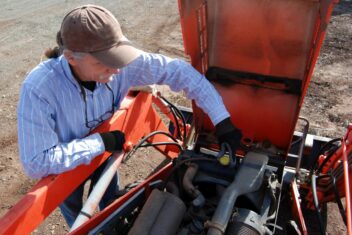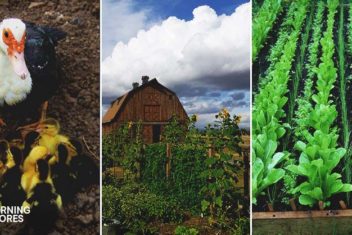It’s almost that time of year again.
No, not planting season. Not lambing. Not farrowing.
It’s mud season, or rather, muddy chicken run season!
It seems as though no matter what we do, we’re always trudging through knee-deep mud here on the farm come springtime. We’ve worked hard to improve our pastures, planting cover crops to help provide structure in the soil and reducing the amount we drive over the vulnerable ground with the tractor.
No matter what, though, the mud returns with a vengeance each spring!
The chicken run is one of the muddiest areas we have to deal with, probably because it rarely gets a rest and chickens are messy little creatures! Fortunately, over the years, we’ve come up with a few helpful ways to reduce the amount of mud we have to deal with. Some of them have been ineffective at best, while others have worked wonders.
If you’re dealing with a muddy chicken run, you may want to read these tips on how to treat and prevent it.
Why Is Your Chicken Run Muddy?
Rainy seasons are a fact of life, and if you have a homestead or farm, you likely embrace those rainy seasons. After all, without rain, your garden can’t grow and your livestock can’t flourish.
However, a lot of rain can lead to a lot of mud in the chicken yard. It’s no secret that rain sitting on top of dirt with more rain is a recipe for muddy conditions. Throw in some spilled feed, coop bedding, and lots and lots of chicken manure, and it’s going to be even muddier.
There are several issues that make the mud issue even worse. For example, if you have drainage issues, you’re going to find that the mud, bedding, and poop just continue to pile up. Run-off from nearby areas can be an issue, as can soil that is naturally poorly-draining (such as clay).
Too much foot or vehicle traffic and erosion from natural causes can also lead to too much mud in the chicken run.
The Problems With a Muddy Chicken Run
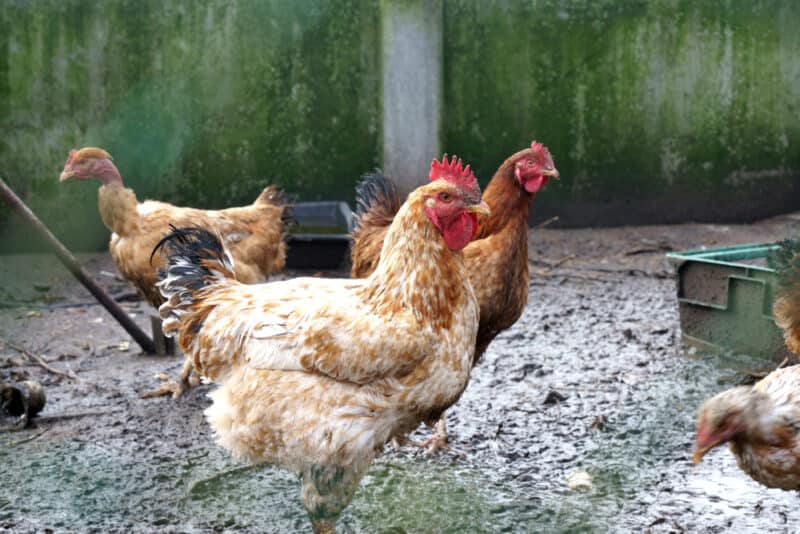
If you’ve ever dealt with a muddy chicken run, you probably don’t need me to tell you that it’s not just highly inconvenient, but it’s also potentially dangerous.
Yes, mud is annoying to traverse through – and it will get your kitchen floors dirty in a hurry when you track in the mud from the outside! It poses other problems, though, too.
First, it can increase the likelihood of erosion – yes, even more so. Once mud arrives, you’re going to have a hard time getting rid of it. It also harbors viruses, fungi, and bacteria, meaning your animals are going to be much more likely to suffer from diseases.
Let’s not forget about all the pests that like hanging out in the mud, either – like flies and mosquitoes.
Of course, mud can also pose hazards in that it increases the likelihood of accidents. How hard is it to walk through a muddy chicken run? Very. You and your chickens are much more likely to trip, fall, and injure yourself if you’re dealing with a mucky run.
How to Fix a Muddy Chicken Run – and Prevent it in the Future
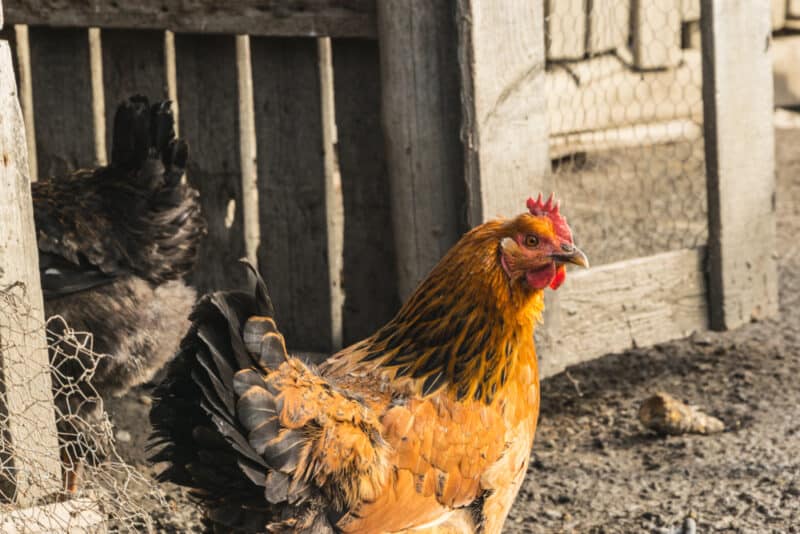
1. Figure Out Where the Mud is Coming From
Before you can do anything else, you need to figure out you have a muddy chicken run in the first place. Do you have drainage issues? A stream running nearby the chicken run that’s spilling into the yard? Perhaps it’s not anything having to do with natural causes at all but instead, your chickens keep knocking over their watering trough and making a mucky mess.
Whatever the case may be, conduct a thorough investigation to figure out where all the mess is coming from. Then and only then can you work toward resolving the issue.
2. Dig Some Trenches
If it’s drainage that’s your issue, you may need to divert some of the water that’s making your chicken run so muddy. To do this, you may need to dig some trenches to work it toward the downward-facing side of the slope so that water runs out of your run instead of into it.
This is best done before the soil gets too muddy, though, if you plan on using any equipment. Using equipment or even adding a lot of foot traffic to your chicken run when it is already vulnerable can make the mud even worse.
3. Fix Any Grading Issues
Often, grading issues can be blamed for a muddy chicken run. This is especially common if you’ve kept your chickens in the same spot for several years or if you have lots of chickens. The bedding will build up over time if you just scoop it out the door and onto the ground.
Even if you don’t, chickens often kick a lot of bedding outside when they walk into and out of the coop, leading to uneven ground outdoors.
Grading can help level out this unevenness and make it easier for water to drain. Again, this is best done with the ground as dry as possible.
4. Grow a Cover Crop
While it won’t work wonders overnight, growing a cover crop in your chicken run is a good way to improve the soil quality over time. Consider an option like cereal rye, winter peas, or crimson clover, all of which will help reduce the mess in the spring if you plant them late in the fall.
5. Add Fill to your Muddy Chicken Run
While I don’t recommend adding organic matter when the soil is already mucky, you may have to consider adding some stone or gravel fill to the yard. Small pebbles and stones are the best options. Some people use wood chips but this can make matters worse, although it will provide your chickens with a softer area to walk on.
6. Build a Walkway
Consider constructing a boardwalk that will help your chickens traverse the chicken run (and you as well). While this won’t take care of the mud right away, it can reduce the amount of foot traffic that keeps tearing up the fragile soil.
7. Partially Cover the Run
Covering at least part of the run serves a few purposes. First, it gives your chickens a place to hide from aerial predators, like hawks. It also gives them a place to be outside during periods of inclement weather, like heavy rain or snow. It also keeps it drier so you shouldn’t have to worry as much about erosion from rainfall, either.
8. Build Some Roosts
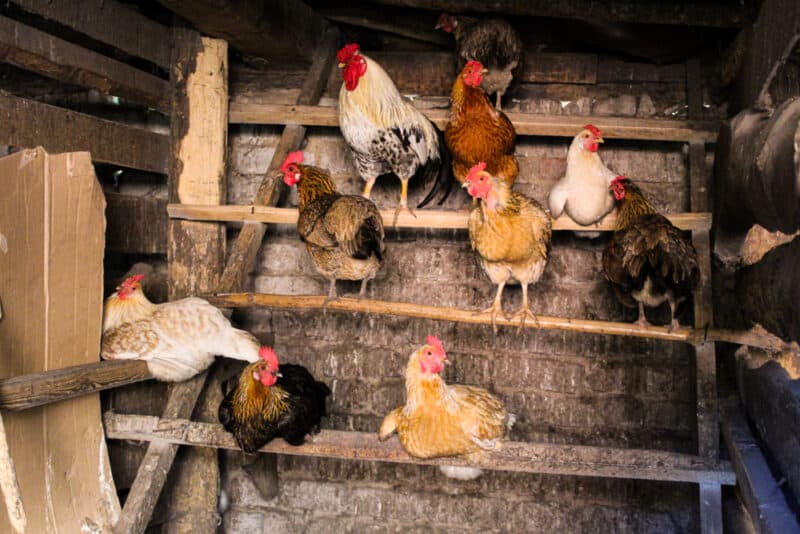
You may have to consider building some outdoor roosts, possibly under your new covered area, to help your chickens dry their feet off when they’re walking around in the mud.
9. Plan Ahead
If you know to expect mud at certain times of the year, you can work to avoid it. Try to use rain catchment systems that will stop mud from accumulating around the coop (you can use this water for your garden, by the way!).
Consider whether certain tasks can be done before or after the muddy season so that you don’t have to make the mud worse – such as driving a tractor around your chicken run.
10. Move Them
Perhaps one of the easiest solutions to a muddy chicken run? Get your chickens off it. Move your chickens to a new area and you will not only not have to deal with the mud but you’ll give the ground some time to dry out, too.
11. Avoid Interim Fixes
I’ll discuss this in more detail below, but you really need to avoid any interim fixes. Although they will improve the situation temporarily, they can make your chicken run even more muddy as they break down.
For example, adding a layer of straw to the chicken run may provide a nice soft pad for your birds to walk on, but it will continue to make a mess of the yard. The same goes for wood chips or pine tree grindings or needles. These are good options to use if the ground is already dry but they’ll get messy as they break down.
Rather than waste your time and money on adding these to the run, I recommend adding them to the coop and nesting boxes instead. That way, your chickens can wipe off their muddy feet once they get inside without creating an even worse mess outdoors.
One exception to using straw is flax straw. Flax straw was once used to make bricks because it takes a very long time to break down. You can usually use this option without having to worry about it making more of a mess – but it can be extremely expensive.
What Not to Do
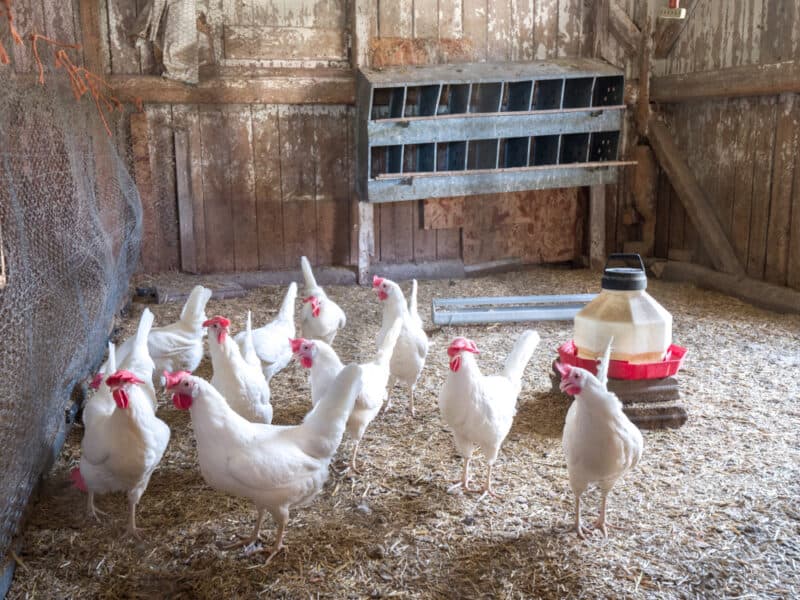
One thing I always recommend that people not do when dealing with mud is to continue tilling or working the area. Chances are if it’s mud in your chicken yard that you’re dealing with, you probably aren’t tilling there anyway.
However, if you’re like me and use your garden as a chicken run during the winter months, you may find that it’s super messy come spring. Resist the urge to mechanically till all of that into the ground. Tilling can destroy soil microorganisms and damage its structure. While it may serve as a good temporary solution, it can cause more problems later on.
You should also avoid other “band-aid” type solutions like adding pine needles or wood shavings. Some people swear by this, convinced that adding more organic matter to the soil will help prevent a muddy chicken run. That’s true – but only partially.
I don’t recommend adding loads of quick-decomposing materials like shavings or pine needles. They’ll break down right away and they won’t do much other than making the mess even soupier. Instead, consider adding compost or other balancing ingredients when the soil is not yet muddy, like in the fall. This could help take care of your problem in the spring.
Fortunately, fixing mud in your chicken run can be done – it’s just going to take some patience. Try to avoid relying on quick fixes and instead, work on improving the quality of the soil in your chicken run over time. While you sometimes can’t avoid mud, you can work to minimize its impact on your flock.


